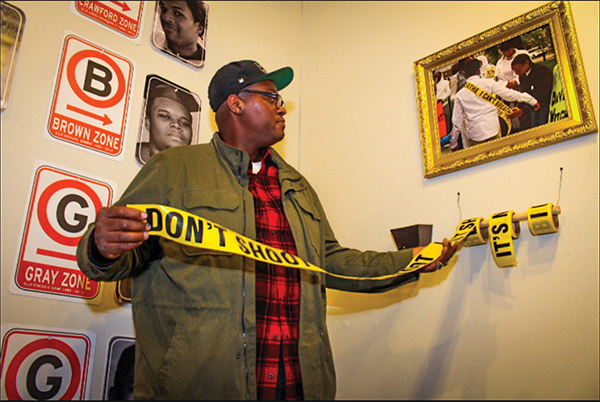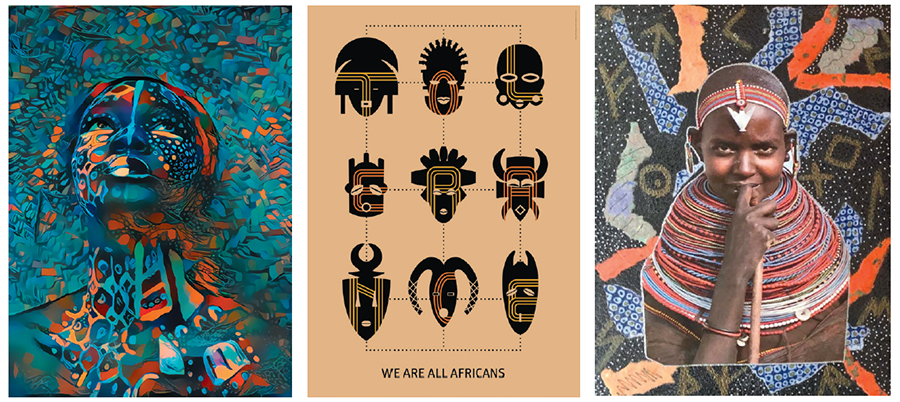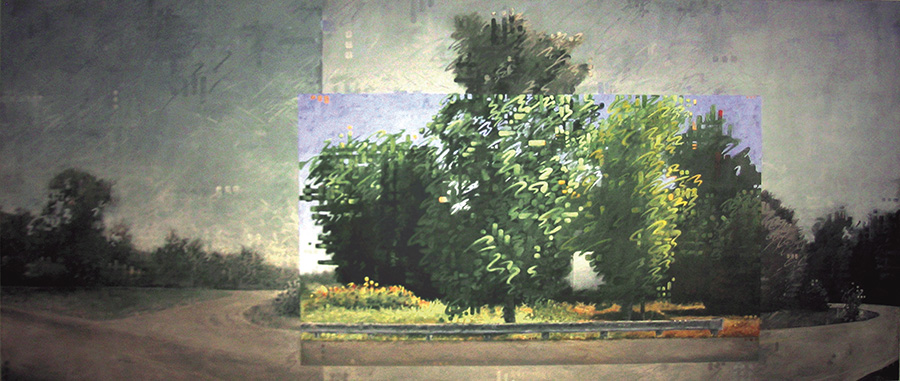Remixing Museum Spaces

The Colored Museum, a performance originally written by Tony Award-winner George C. Wolfe, is being revitalized by Boston-based director/dramaturg/educator Pascale Florestal at The Umbrella Arts Center in Concord, MA. In tandem with the live performance, the venue will double as a gallery with a show curated by local street artist and social interventionist, Cedric “Vise1” Douglas. The exhibit, The Colored Museum: Past/Present/Future Gallery blends diverse styles and mediums on the African diaspora.
After researching The Colored Museum, a satire, Douglas organized the exhibit with BIPOC artists who focus on the three tenses: historical, present day protest art, and Afrofuturism. He then selected the pieces that best represented each period. Walking through the exhibit and into the theater space, the audience will have the opportunity to view eight Black local artists including a former inmate of the Massachusetts Correctional Institution (MCI) also located in Concord. Other celebrated artists include Keith Morris Washington, Chaz Maviyane-Davies, Shea Justice, Nicholas Johnson, Ifé Franklin, Nettrice Gaskins, and Barrington Edwards. Douglas’ own piece, Tools of Protest, will be on display—an idea inspired after the killing of Terrence Coleman. Douglas designed caution tape, similar to what police would use in a crime scene. “I was thinking of the last words when Eric Garner passed away and John Crawford III passed away, their last words. Imagine creating a memorial of someone’s words and to feel that.” After George Floyd was killed, Douglas passed out these tapes, meant to glow in the night, to illuminate at the protests.

Another artist in the show, Shea Justice, from Roxbury, MA, began illustrating on rice scrolls to document the start of the United States involvement in the Middle East from 2000. Twenty years later, with Biden’s withdrawal of the remaining troops from Afghanistan, the scrolls now measure over a mile and a half long. “I didn’t realize it would be the longest war in American history.” The scrolls weigh about 25 pounds and will be displayed with most of the sides rolled up. “There’s a lot there,” says the artist of this time in history. “I’ve put [what you know] in visual context.”
As a graffiti artist, Douglas grew up making art wherever it was needed. A notable shift in his perspective came when he read an article about LEE, a graffiti artist in New York, who began tagging ‘Stop the Bombs,’ during the Cold War. “I thought graffiti was all about your identity, but he flipped it and made a social message out of it,” said Douglas of the memory. A graduate of Massachusetts College of Art and Design, in Boston, MA, Douglas is now both a studio artist and street artist, preferring public art for the access to the community and the conversation that it produces. Passersby can see the evolution of a mural and watch the process from beginning to end. This exhibit is meant to blend both experiences of studio and street. “I do public art because I want to have these conversations with everyone. I don’t want to just have it in a gallery setting with a select few.”

There is poignancy in the play and the exhibit being presented in Concord, a predominately white suburb of Boston, where the home of the famed author Louisa May Alcott’s Orchard House can neighbor a correctional facility. Douglas hopes the geographic location will create connections in the community and also invite people of color to a white space: the neighborhood itself and the historic whiteness of museums and galleries. Including Justin Printice Douglass, a former inmate of MCI, in the exhibit was born of an intention to showcase the artist’s work posthumously and start a larger conversation of race, inclusivity, and the penal system. Douglas is adding an interactive piece to enhance the level of audience engagement. “People are talking and having conversations right there and talking about the kind of experience of diversity within the performance. I want that—that is my ideal and how we put it out in the world.”
Douglas wonders about future interpretations of The Colored Museum and how the idea may dismantle artistic spaces. Historically, art institutions were restrictive, excluding BIPOC artists, and even local artists. In one skit, Wolfe quite literally puts Black actors on display. After seeing Florestal’s rendition of the play, the audience will experience Black art on view. Douglas hopes this will start conversations about how we consume art and make it more accessible and affordable. In this spirit of future gallery spaces, Douglas imagines a dismantling of the old guard policies to de-marketize museums. Even the idea of donations can be revised by passing the funds onto the artists who exhibit instead of to these museums that hold large endowments, according to Douglas. “[This show] is about remixing the traditional museum space.”
The schedule includes the opening, a curator talk, a series with The Robbins House and the town’s African American History of Concord Walking Tour which will lead up to Juneteenth. A concurrent teen exhibit curated by Nayda Cuevas will be on display in Umbrella’s Black Box Theater.
– Jennifer Mancuso
